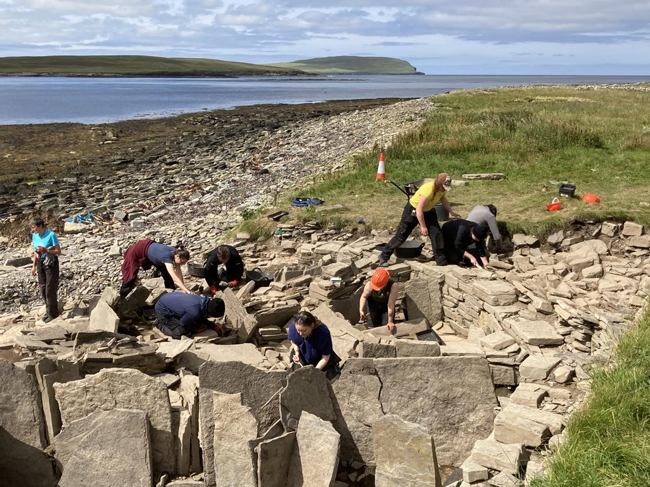Dedicated and enthusiastic field team members led by Dr Julie Bond (University of Bradford) are battling time and tides to document an Iron Age settlement and other important archaeological finds before the elements take their toll.
Dedicated and Enthusiastic Archaeologists
Dr Bond with her colleagues and students studying Archaeological and Forensic Sciences are battling against erosion to uncover artefacts and document the site located on the island of Rousay in the Orkneys (Scotland).

A Large Iron Age Settlement
The site, located at the Knowe of Swandro, on the west coast of Rousay has been occupied from around 1000BC to AD1200. As well as the Iron Age roundhouses, there are the remains of Pict buildings, a Viking settlement and a Norse Long Hall, all of which are threatened by coastal erosion.
The area is considered to be one of the most important locations for documenting the history of Scandinavian settlers in the British Isles.
Honorary Researcher, Dr Steve Dockrill warned that this project is a race against tides and time. Nature will win in the end, but the hardworking team are determined to map and document the site and collect artefacts to preserve evidence of human habitation.
Dr Dockrill stated:
“A substantial Iron Age roundhouse, which forms the focus of a village-like settlement is being eroded by the sea. The large roundhouse had been lived in by generations for a millennium or more, and shows signs of a number of building events modifying the structure.”
Coastal Erosion
Coastal erosion, accelerated by rising sea levels is an increasing threat to sites such as these. The Knowe of Swandro location is providing archaeologists with a unique opportunity to explore the construction of the roundhouse and surrounding buildings.
Dr Dockrill added:
“The site is rich in cultural material and evidence for the use of land and sea in terms of agriculture and fishing. This site is being destroyed by the sea. Over a third of the roundhouse has been lost to coastal erosion. Despite this we are uncovering new evidence for life in the Iron Age and are using the latest technology to record the archaeological evidence before it vanishes”
The University of Bradford-led excavation is working in partnership with the Swandro Orkney Coastal Archaeology Trust, to investigate the site. The Swandro Orkney Coastal Archaeology Trust relies on public donations to fund its work and has HRH Prince Charles as its patron.
To date, the dedicated team have found bone tools, jewellery, shards of pottery and a late Roman coin. A rare Iron Age glass bead has also been uncovered, this could have been part of a piece of jewellery or perhaps a gaming piece.
Students from the University of Bradford on the Archaeological and Forensic Sciences course travel to the Orkneys to gain practical work experience.
Student Michal Szedzielorz commented:
“This is an amazing experience. I have learnt more in 6 weeks than I ever expected. I have learnt so many new practical skills and a better understanding of archaeology.”
A spokesperson from Everything Dinosaur commented:
“Whilst the actions of waves and tides can reveal archaeological and palaeontological treasures, these same forces can destroy, and we wish all the field team members every success with their endeavours.”
Everything Dinosaur acknowledges the assistance of a media release from the University of Bradford in the compilation of this article.
Visit Everything Dinosaur’s award-winning website: Visit Everything Dinosaur.






Leave A Comment